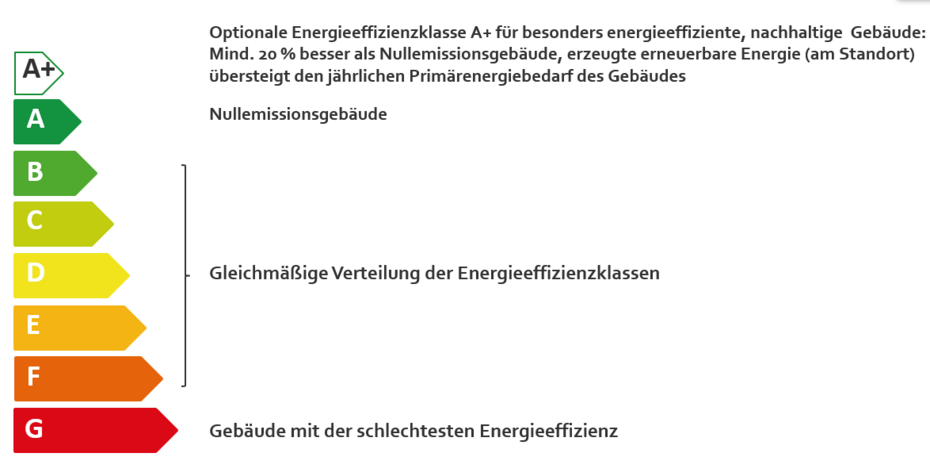
Building Directive
Amendment to the European Buildings Directive
From nearly zero-energy to zero-emission buildings by 2050
In December 2023, a political agreement was reached in the negotiations for the revision of the Buildings Directive at EU level. The amendment to the Buildings Directive was formally adopted by the EU Parliament on 12 March 2024[1] and by the Council on 12 April 2024. It can therefore be assumed that the Buildings Directive will officially enter into force in the coming weeks. The member states will then have two years (Q2 2026) to transpose the provisions of the directive into national law.
Renovation of the building stock and phasing out fossil heating systems
The revised Buildings Directive contains a series of measures to structurally improve the energy efficiency of existing buildings. The focus is on buildings with the lowest energy efficiency
In a first step, the member states are to define minimum energy efficiency standards. A distinction is made between residential and non-residential buildings as follows.
For residential buildings the following applies:
- Define a national trajectory to reduce the average primary energy consumption of the building stock by 16% by 2030 and by 20 to 22% by 2035 compared to 2020 (expressed in kWh/m2a)
- The reduction in primary energy consumption by at least 55% must be achieved by renovating the buildings with the poorest energy efficiency
For non-residential buildings the following applies:
- Renovation obligation for the worst 16% of buildings by 2030 and the worst 26% by 2033
In general, Member States must draw up national building renovation plans that set clear targets for the conversion of the building stock to zero emissions buildings by 2050 (both public and private residential and non-residential buildings) based on the minimum energy efficiency standards.
The plans must include interim targets for the years 2030 and 2040, and the plan must also include the phase-out of fossil-fuelled heating systems by 2040. The plans must also show how remaining obstacles will be removed, for example in terms of financing, training and attracting the necessary skilled labour.
With regard to renovation efforts, one point of the directive includes building renovation passports. These are intended to support building owners in the gradual and comprehensive renovation towards zero-emission buildings. Another point provides for the establishment of central contact points ('one-stop shops') to support all players in the value chain with targeted, independent advisory services for the renovation of buildings.
Zero-emission buildings, new energy certificates and promotion of renewable energy sources
In addition to the phase-out of fossil fuels in existing buildings, new buildings are to be constructed based on the new standard for zero-emission buildings according to the following schedule:
- New public buildings: from 1 January 2028
- All new buildings: from 1 January 2030
The standard for zero-emission buildings is developed by the member states, based on cost optimisation calculations with the aim of minimising primary energy demand. The remaining energy requirement is to be covered by renewable energy sources. In any case, zero-emission buildings must not emit any emissions from fossil fuels on site!
The new energy performance certificate covers energy efficiency classes A to G. Class A is intended for zero emission buildings, Class G for buildings with the worst energy efficiency class
Optional energy efficiency class A+ for particularly energy-efficient, sustainable buildings: at least 20 % better than zero-emission buildings, renewable energy generated (on site) exceeds the building's annual primary energy requirement.

The issued energy performance certificates are to be stored in a national database, which can be linked to other databases (e.g. the national building or property register). Aggregated data on the energy performance of buildings, including energy consumption and other relevant parameters, will be made publicly available and updated at least twice a year. Further anonymised or aggregated information will be made available to the public and research institutions on request.
Member states must ensure that new buildings are solar-ready, i.e. suitable for the installation of photovoltaic or solar thermal systems on the roof. The installation of solar energy is becoming standard for new buildings. The regulations come into force at different times depending on the type of building (especially public buildings and non-residential buildings) and size.
Financial incentives, combating energy poverty and skilled labour
The investment required to implement the building renovation plans requires significant financial resources. Member States shall support these measures by Mobilising the required investment through effective financing options, creating funding incentives and other supporting measures to remove existing technical and non-technical market barriers (such as training initiatives and attracting additional skilled and labour).
In addition, Member States must put in place safeguards for tenants to counteract the risk of vulnerable households being evicted due to disproportionate rent increases following renovation. Particular focus is to be placed on reducing energy poverty by lowering energy costs.
Comprehensive renovations or gradual renovations with the aim of comprehensive renovation are to be achieved through increased financial, tax and administrative support. If it is not technically or economically feasible to convert an existing building into a zero-emission building, a renovation that leads to a reduction in primary energy consumption of at least 60 % is considered a comprehensive renovation. The funding incentives should not only be aimed at individual buildings, but also at a larger number of buildings (including neighbourhoods).
Modernisation of technical building equipment, sustainable mobility and minimisation of grey energy!
The modernisation of technical building equipment is a priority, with a focus on increasing both energy efficiency and the proportion of renewable energy sources (including storage systems). The new requirements should also help to create a healthy indoor climate and improve the quality of indoor air.
Building automation systems and automatic lighting systems (if technically and economically feasible) will become mandatory for non-residential buildings with an effective rated output for heating, ventilation and cooling of over 70 kW by 31 December 2029. For outputs above 290 kW, the requirements will come into force earlier, from 2024 and 2027 respectively.
For new residential buildings or buildings undergoing extensive refurbishment, the degree of automation of the technical building equipment is also to be significantly increased.
In addition, the agreed regulations promote the spread of sustainable mobility solutions as they contain provisions on charging infrastructure, charging points for electric vehicles and bicycle parking spaces.
Pre-wiring will become standard for new and renovated buildings. This facilitates access to charging infrastructure and contributes to the EU's climate targets. In addition, the requirements for the number of charging points in both residential and non-residential buildings will be increased. Member States must also remove barriers to the installation of charging stations in order to put the right to a charging infrastructure into practice. In general, charging stations must enable intelligent and, if necessary, bidirectional charging. Last but not least, it must be ensured that sufficient parking spaces are available for bicycles.
The vision for a decarbonised building stock by 2050 goes beyond the current focus on operational greenhouse gas emissions. For this reason, the life cycle emissions of buildings are also taken into account. Starting with new buildings, for which limit values must be set by the member states from 2030, the grey energy for the entire building stock is to be successively reduced.
[1] Energy performance of buildings (P9 TA(2024)0129), legislative resolution of the European Parliament of 12 March 2024 on the proposal for a directive on the energy performance of buildings. European Parliament legislative resolution of 12 March 2024 on the proposal for a directive of the European Parliament and of the Council on the energy performance of buildings (recast) (COM(2021)0802 - C9-0469/2021.
Contact person

Head of Center Buildings & Energy Efficiency Monitoring
DI Dr. Günter Simader
Email addressguenter.simader@energyagency.at